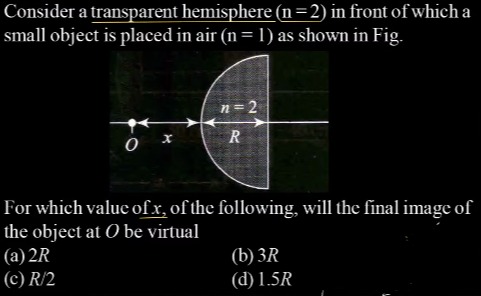Question
Question: Consider a transparent hemisphere (n = 2) in front of which a small object is placed in air (n = 1) ...
Consider a transparent hemisphere (n = 2) in front of which a small object is placed in air (n = 1) as shown in Fig.
For which value of x, of the following, will the final image of the object at O be virtual

2R
3R
R/2
1.5R
2R
Solution
When the object at O (located a distance x to the left of the flat face) emits rays, these rays enter the hemisphere normally through its flat surface so that their direction is unchanged. They then travel in the glass (n = 2) and refract when emerging from the spherical (curved) surface into air (n = 1). In the spherical-surface refraction formula
vn2−un1=Rn2−n1,the effective object for the curved surface is the point where the rays appear to come from in the glass. Since the flat face passes through the center of the sphere, the vertex of the curved surface is at a distance R from it. Therefore, the distance from the vertex to O is
u=R+x.For the final image to appear at O (i.e. the object is imaged into itself and the image is virtual), the image distance must be
v=−(R+x)(negative sign indicating a virtual image on the same side as the object).
Substituting into the formula with n1=2 and n2=1:
−(R+x)1−R+x2=R1−2=−R1.The left side becomes:
−R+x1−R+x2=−R+x3.Thus, equating
−R+x3=−R1⟹R+x3=R1⟹R+x=3R.Solving gives
x=2R.